Management and Business Context: Cross-Cultural Management Report
VerifiedAdded on 2020/05/28
|12
|2874
|33
Report
AI Summary
This report delves into the critical importance of cross-cultural elements in global business expansion, specifically addressing the challenges and opportunities for a currency consultancy firm. It leverages Hofstede's theory of cultural dimensions to analyze the Australian workforce and offers practical strategies for implementing cross-cultural management principles. The report explores the impact of cultural values on business practices, organizational structure, and employee performance, emphasizing the need for cultural awareness and diversity training. It provides recommendations for fostering effective communication, resolving conflicts, and optimizing human resource policies to build a culturally diverse and productive workforce. The study highlights the significance of understanding cultural differences, leveraging strengths like the Australian workforce's self-reliance and risk-taking abilities, and addressing potential challenges such as uncertainty avoidance to ensure success in an increasingly interconnected global market.
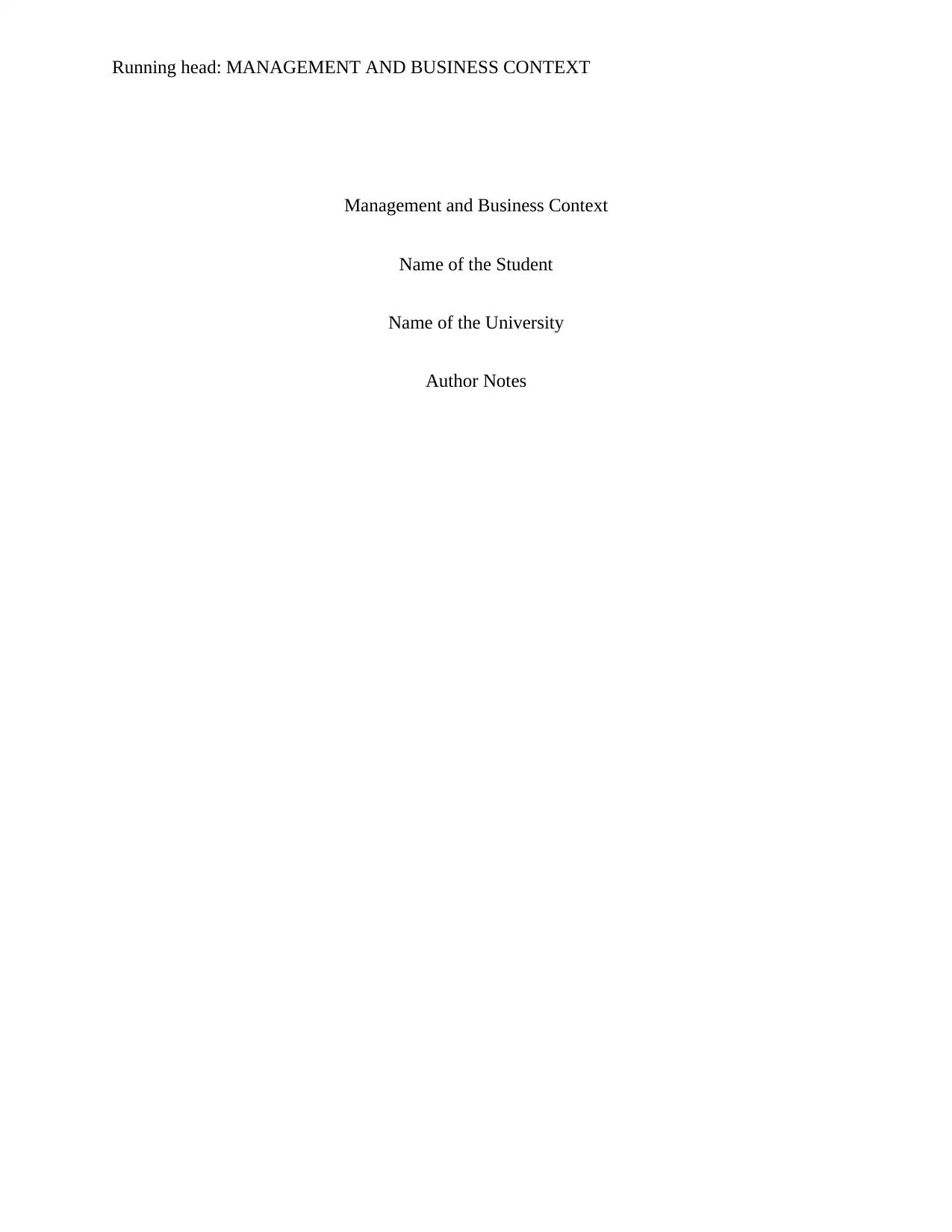
Running head: MANAGEMENT AND BUSINESS CONTEXT
Management and Business Context
Name of the Student
Name of the University
Author Notes
Management and Business Context
Name of the Student
Name of the University
Author Notes
Paraphrase This Document
Need a fresh take? Get an instant paraphrase of this document with our AI Paraphraser
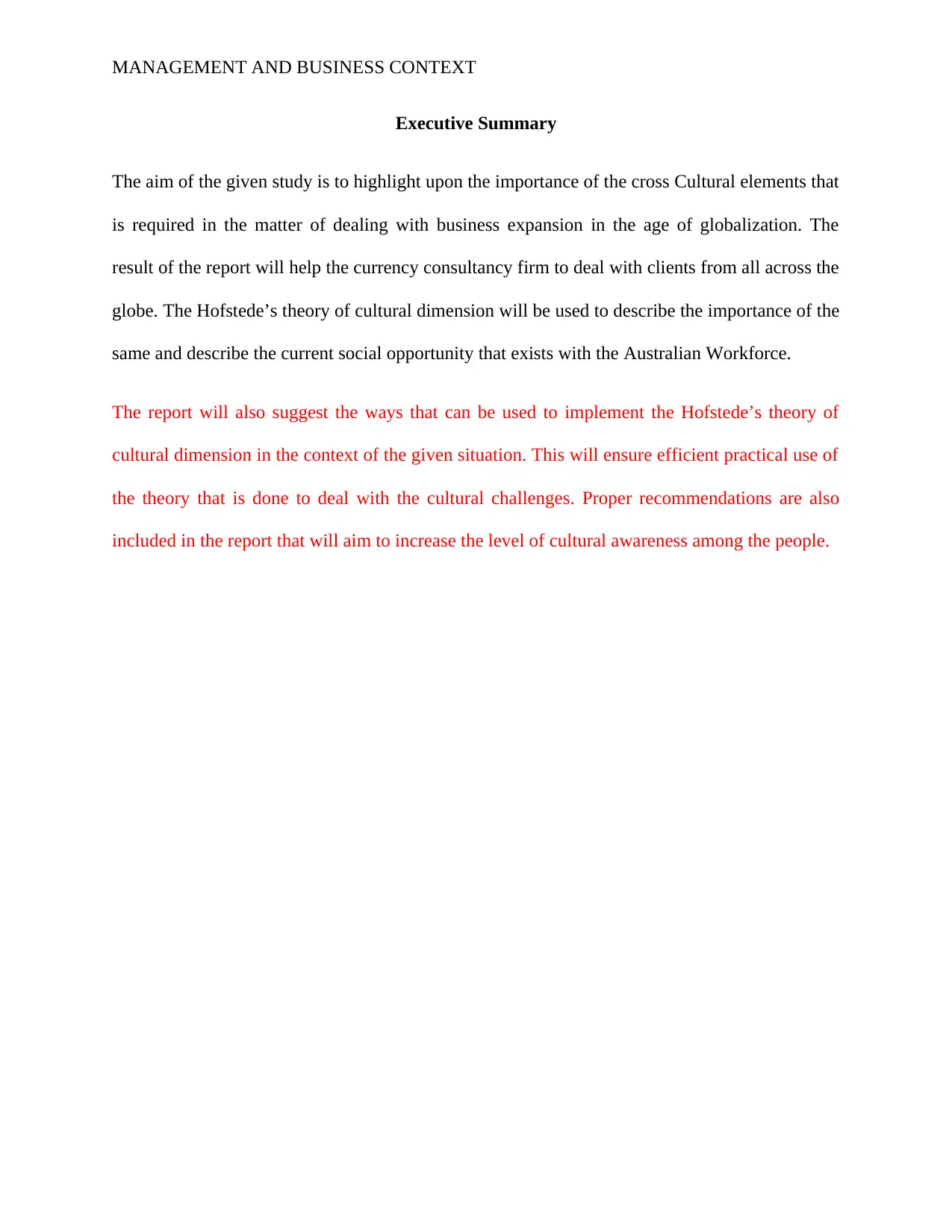
MANAGEMENT AND BUSINESS CONTEXT
Executive Summary
The aim of the given study is to highlight upon the importance of the cross Cultural elements that
is required in the matter of dealing with business expansion in the age of globalization. The
result of the report will help the currency consultancy firm to deal with clients from all across the
globe. The Hofstede’s theory of cultural dimension will be used to describe the importance of the
same and describe the current social opportunity that exists with the Australian Workforce.
The report will also suggest the ways that can be used to implement the Hofstede’s theory of
cultural dimension in the context of the given situation. This will ensure efficient practical use of
the theory that is done to deal with the cultural challenges. Proper recommendations are also
included in the report that will aim to increase the level of cultural awareness among the people.
Executive Summary
The aim of the given study is to highlight upon the importance of the cross Cultural elements that
is required in the matter of dealing with business expansion in the age of globalization. The
result of the report will help the currency consultancy firm to deal with clients from all across the
globe. The Hofstede’s theory of cultural dimension will be used to describe the importance of the
same and describe the current social opportunity that exists with the Australian Workforce.
The report will also suggest the ways that can be used to implement the Hofstede’s theory of
cultural dimension in the context of the given situation. This will ensure efficient practical use of
the theory that is done to deal with the cultural challenges. Proper recommendations are also
included in the report that will aim to increase the level of cultural awareness among the people.
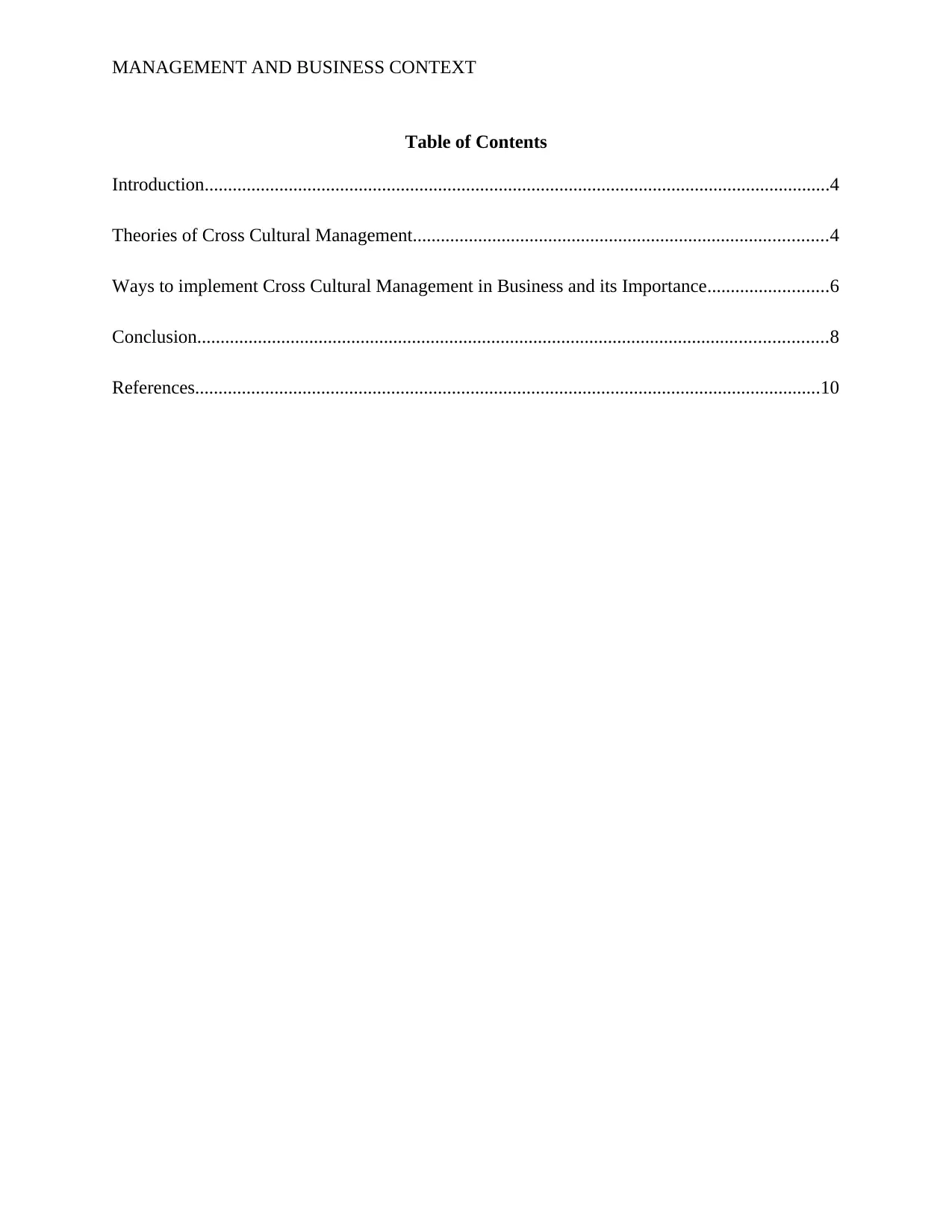
MANAGEMENT AND BUSINESS CONTEXT
Table of Contents
Introduction......................................................................................................................................4
Theories of Cross Cultural Management.........................................................................................4
Ways to implement Cross Cultural Management in Business and its Importance..........................6
Conclusion.......................................................................................................................................8
References......................................................................................................................................10
Table of Contents
Introduction......................................................................................................................................4
Theories of Cross Cultural Management.........................................................................................4
Ways to implement Cross Cultural Management in Business and its Importance..........................6
Conclusion.......................................................................................................................................8
References......................................................................................................................................10
⊘ This is a preview!⊘
Do you want full access?
Subscribe today to unlock all pages.

Trusted by 1+ million students worldwide
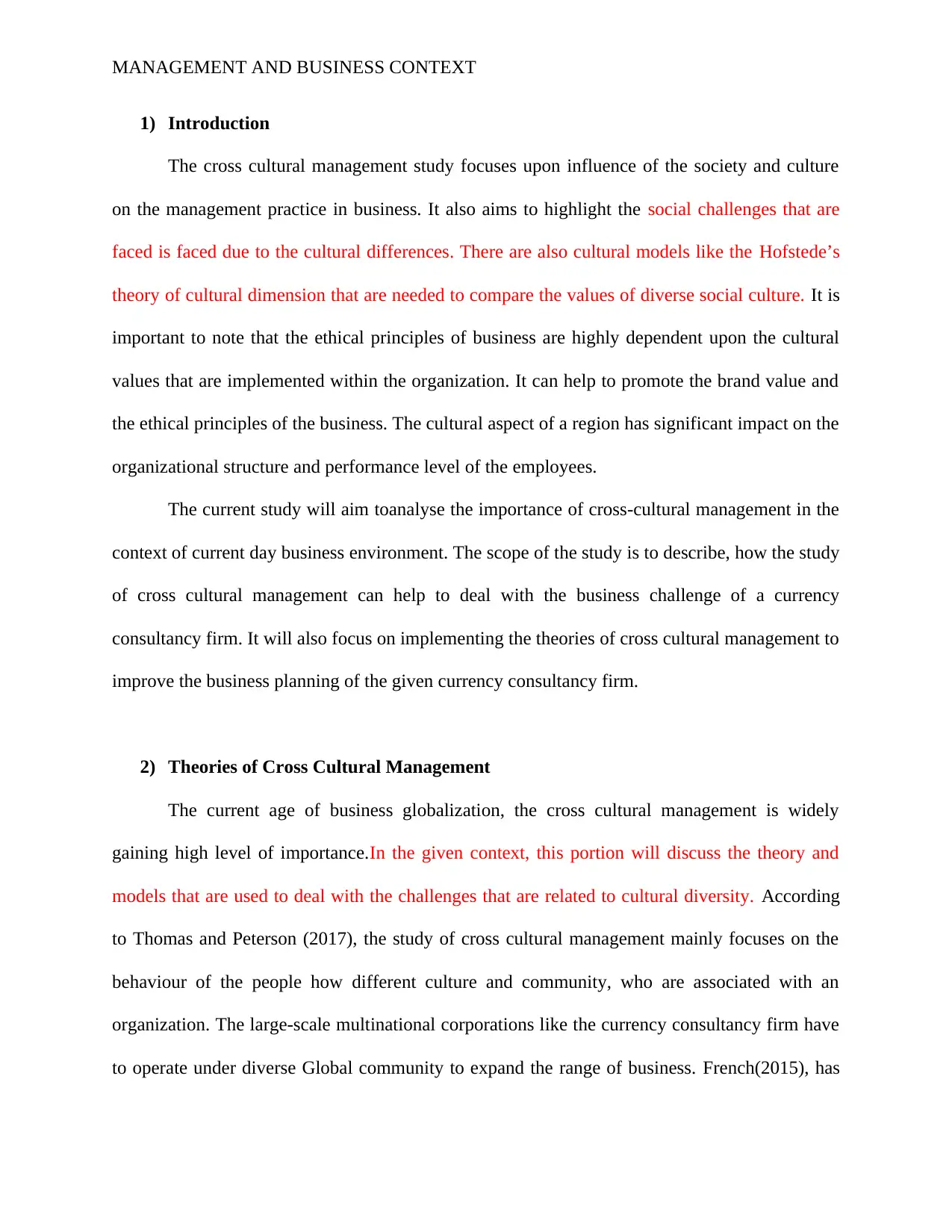
MANAGEMENT AND BUSINESS CONTEXT
1) Introduction
The cross cultural management study focuses upon influence of the society and culture
on the management practice in business. It also aims to highlight the social challenges that are
faced is faced due to the cultural differences. There are also cultural models like the Hofstede’s
theory of cultural dimension that are needed to compare the values of diverse social culture. It is
important to note that the ethical principles of business are highly dependent upon the cultural
values that are implemented within the organization. It can help to promote the brand value and
the ethical principles of the business. The cultural aspect of a region has significant impact on the
organizational structure and performance level of the employees.
The current study will aim toanalyse the importance of cross-cultural management in the
context of current day business environment. The scope of the study is to describe, how the study
of cross cultural management can help to deal with the business challenge of a currency
consultancy firm. It will also focus on implementing the theories of cross cultural management to
improve the business planning of the given currency consultancy firm.
2) Theories of Cross Cultural Management
The current age of business globalization, the cross cultural management is widely
gaining high level of importance.In the given context, this portion will discuss the theory and
models that are used to deal with the challenges that are related to cultural diversity. According
to Thomas and Peterson (2017), the study of cross cultural management mainly focuses on the
behaviour of the people how different culture and community, who are associated with an
organization. The large-scale multinational corporations like the currency consultancy firm have
to operate under diverse Global community to expand the range of business. French(2015), has
1) Introduction
The cross cultural management study focuses upon influence of the society and culture
on the management practice in business. It also aims to highlight the social challenges that are
faced is faced due to the cultural differences. There are also cultural models like the Hofstede’s
theory of cultural dimension that are needed to compare the values of diverse social culture. It is
important to note that the ethical principles of business are highly dependent upon the cultural
values that are implemented within the organization. It can help to promote the brand value and
the ethical principles of the business. The cultural aspect of a region has significant impact on the
organizational structure and performance level of the employees.
The current study will aim toanalyse the importance of cross-cultural management in the
context of current day business environment. The scope of the study is to describe, how the study
of cross cultural management can help to deal with the business challenge of a currency
consultancy firm. It will also focus on implementing the theories of cross cultural management to
improve the business planning of the given currency consultancy firm.
2) Theories of Cross Cultural Management
The current age of business globalization, the cross cultural management is widely
gaining high level of importance.In the given context, this portion will discuss the theory and
models that are used to deal with the challenges that are related to cultural diversity. According
to Thomas and Peterson (2017), the study of cross cultural management mainly focuses on the
behaviour of the people how different culture and community, who are associated with an
organization. The large-scale multinational corporations like the currency consultancy firm have
to operate under diverse Global community to expand the range of business. French(2015), has
Paraphrase This Document
Need a fresh take? Get an instant paraphrase of this document with our AI Paraphraser
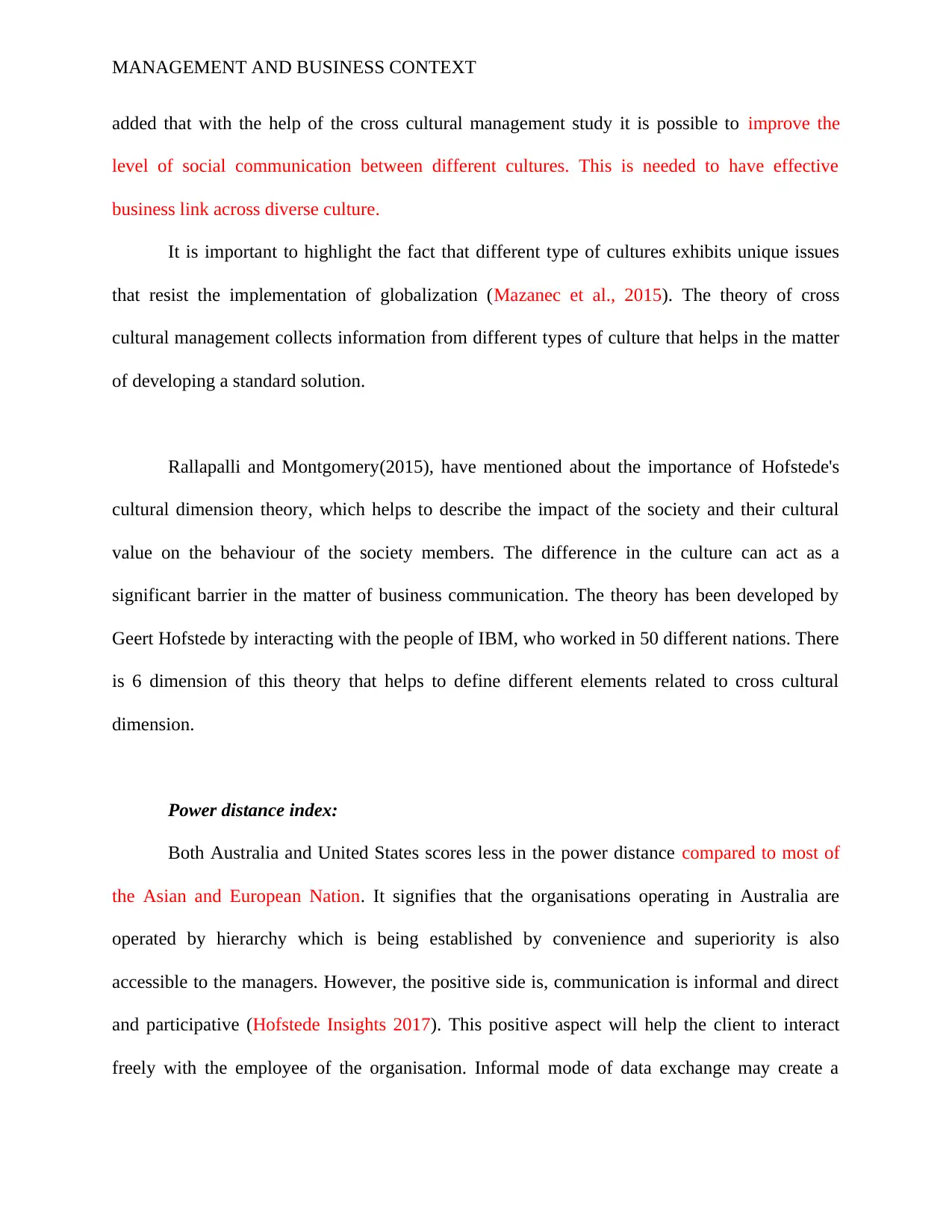
MANAGEMENT AND BUSINESS CONTEXT
added that with the help of the cross cultural management study it is possible to improve the
level of social communication between different cultures. This is needed to have effective
business link across diverse culture.
It is important to highlight the fact that different type of cultures exhibits unique issues
that resist the implementation of globalization (Mazanec et al., 2015). The theory of cross
cultural management collects information from different types of culture that helps in the matter
of developing a standard solution.
Rallapalli and Montgomery(2015), have mentioned about the importance of Hofstede's
cultural dimension theory, which helps to describe the impact of the society and their cultural
value on the behaviour of the society members. The difference in the culture can act as a
significant barrier in the matter of business communication. The theory has been developed by
Geert Hofstede by interacting with the people of IBM, who worked in 50 different nations. There
is 6 dimension of this theory that helps to define different elements related to cross cultural
dimension.
Power distance index:
Both Australia and United States scores less in the power distance compared to most of
the Asian and European Nation. It signifies that the organisations operating in Australia are
operated by hierarchy which is being established by convenience and superiority is also
accessible to the managers. However, the positive side is, communication is informal and direct
and participative (Hofstede Insights 2017). This positive aspect will help the client to interact
freely with the employee of the organisation. Informal mode of data exchange may create a
added that with the help of the cross cultural management study it is possible to improve the
level of social communication between different cultures. This is needed to have effective
business link across diverse culture.
It is important to highlight the fact that different type of cultures exhibits unique issues
that resist the implementation of globalization (Mazanec et al., 2015). The theory of cross
cultural management collects information from different types of culture that helps in the matter
of developing a standard solution.
Rallapalli and Montgomery(2015), have mentioned about the importance of Hofstede's
cultural dimension theory, which helps to describe the impact of the society and their cultural
value on the behaviour of the society members. The difference in the culture can act as a
significant barrier in the matter of business communication. The theory has been developed by
Geert Hofstede by interacting with the people of IBM, who worked in 50 different nations. There
is 6 dimension of this theory that helps to define different elements related to cross cultural
dimension.
Power distance index:
Both Australia and United States scores less in the power distance compared to most of
the Asian and European Nation. It signifies that the organisations operating in Australia are
operated by hierarchy which is being established by convenience and superiority is also
accessible to the managers. However, the positive side is, communication is informal and direct
and participative (Hofstede Insights 2017). This positive aspect will help the client to interact
freely with the employee of the organisation. Informal mode of data exchange may create a
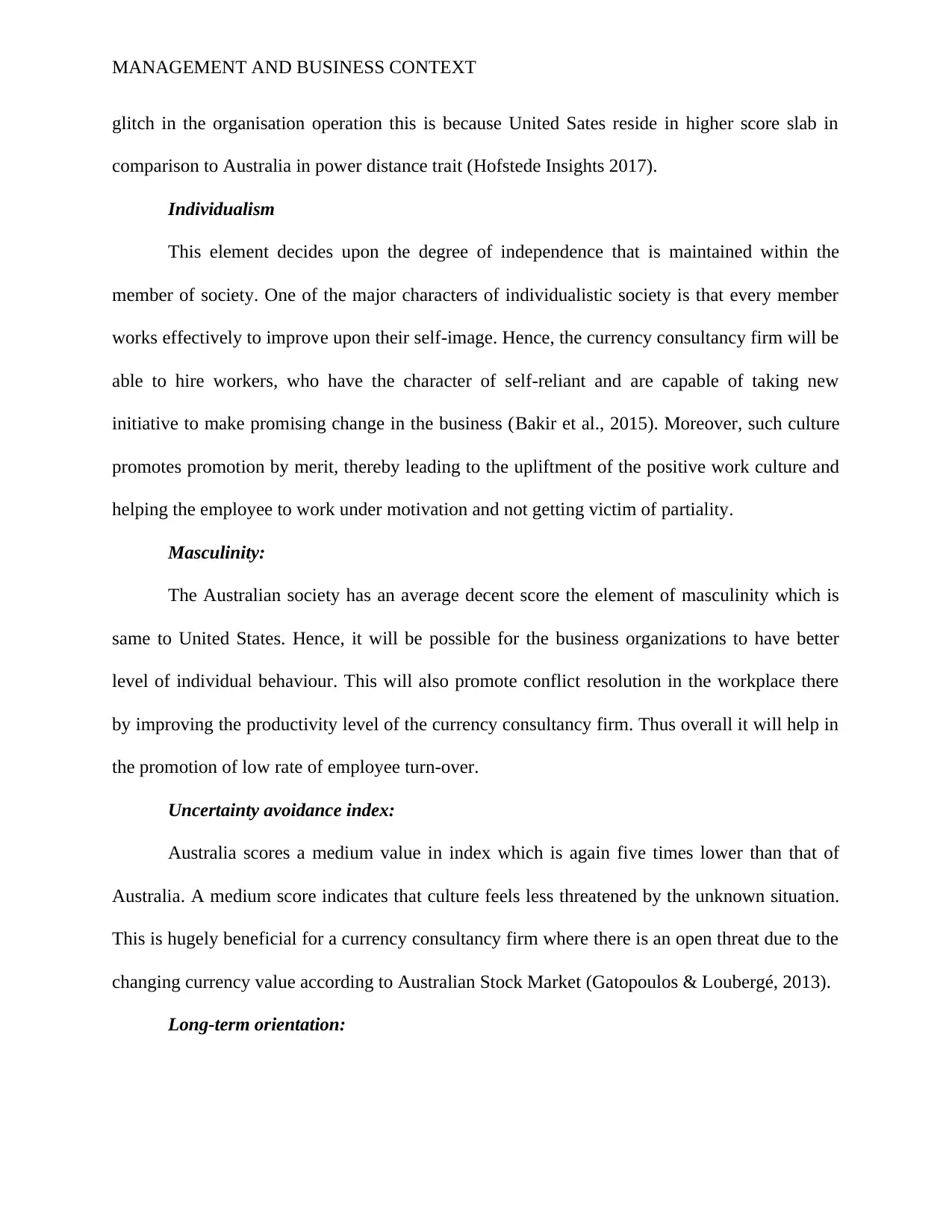
MANAGEMENT AND BUSINESS CONTEXT
glitch in the organisation operation this is because United Sates reside in higher score slab in
comparison to Australia in power distance trait (Hofstede Insights 2017).
Individualism
This element decides upon the degree of independence that is maintained within the
member of society. One of the major characters of individualistic society is that every member
works effectively to improve upon their self-image. Hence, the currency consultancy firm will be
able to hire workers, who have the character of self-reliant and are capable of taking new
initiative to make promising change in the business (Bakir et al., 2015). Moreover, such culture
promotes promotion by merit, thereby leading to the upliftment of the positive work culture and
helping the employee to work under motivation and not getting victim of partiality.
Masculinity:
The Australian society has an average decent score the element of masculinity which is
same to United States. Hence, it will be possible for the business organizations to have better
level of individual behaviour. This will also promote conflict resolution in the workplace there
by improving the productivity level of the currency consultancy firm. Thus overall it will help in
the promotion of low rate of employee turn-over.
Uncertainty avoidance index:
Australia scores a medium value in index which is again five times lower than that of
Australia. A medium score indicates that culture feels less threatened by the unknown situation.
This is hugely beneficial for a currency consultancy firm where there is an open threat due to the
changing currency value according to Australian Stock Market (Gatopoulos & Loubergé, 2013).
Long-term orientation:
glitch in the organisation operation this is because United Sates reside in higher score slab in
comparison to Australia in power distance trait (Hofstede Insights 2017).
Individualism
This element decides upon the degree of independence that is maintained within the
member of society. One of the major characters of individualistic society is that every member
works effectively to improve upon their self-image. Hence, the currency consultancy firm will be
able to hire workers, who have the character of self-reliant and are capable of taking new
initiative to make promising change in the business (Bakir et al., 2015). Moreover, such culture
promotes promotion by merit, thereby leading to the upliftment of the positive work culture and
helping the employee to work under motivation and not getting victim of partiality.
Masculinity:
The Australian society has an average decent score the element of masculinity which is
same to United States. Hence, it will be possible for the business organizations to have better
level of individual behaviour. This will also promote conflict resolution in the workplace there
by improving the productivity level of the currency consultancy firm. Thus overall it will help in
the promotion of low rate of employee turn-over.
Uncertainty avoidance index:
Australia scores a medium value in index which is again five times lower than that of
Australia. A medium score indicates that culture feels less threatened by the unknown situation.
This is hugely beneficial for a currency consultancy firm where there is an open threat due to the
changing currency value according to Australian Stock Market (Gatopoulos & Loubergé, 2013).
Long-term orientation:
⊘ This is a preview!⊘
Do you want full access?
Subscribe today to unlock all pages.

Trusted by 1+ million students worldwide
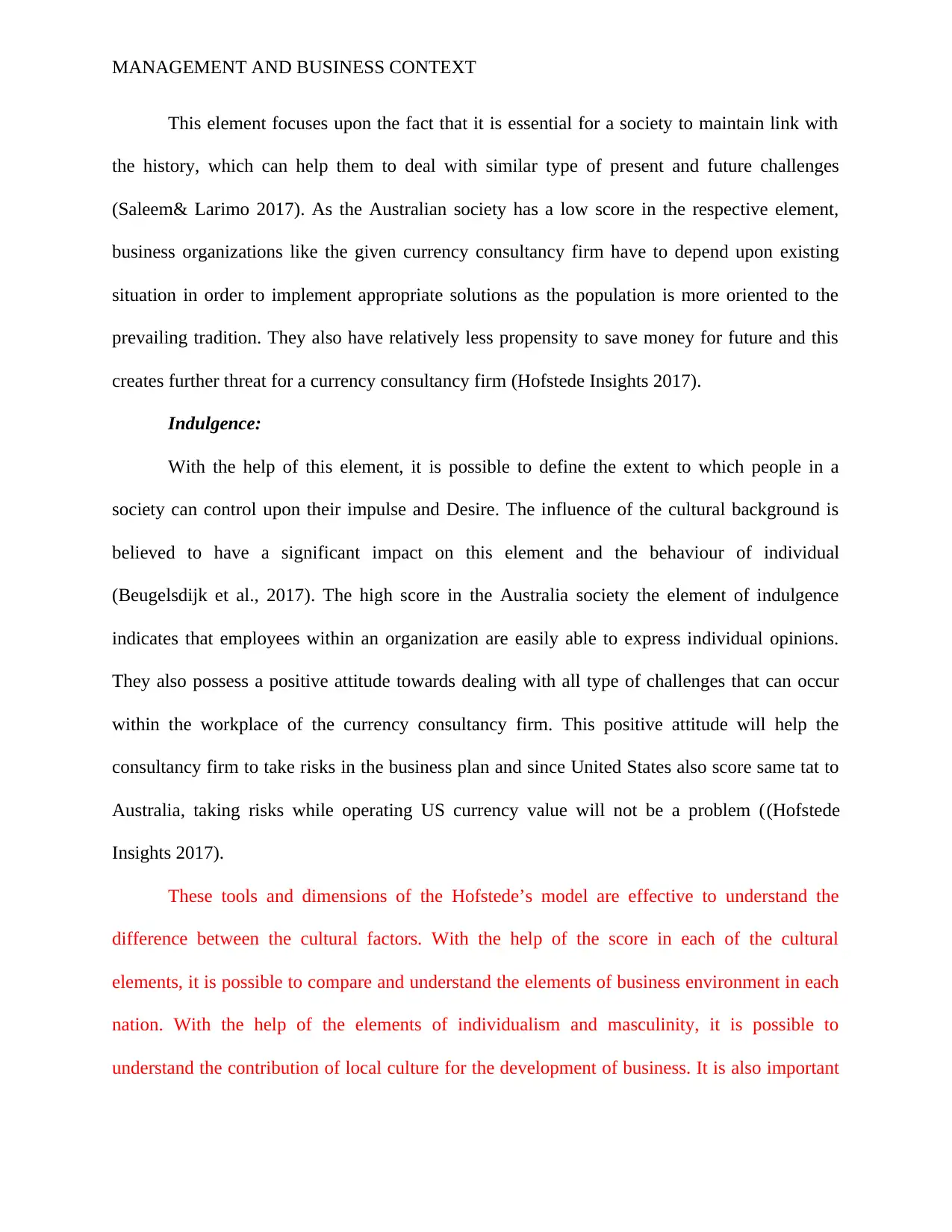
MANAGEMENT AND BUSINESS CONTEXT
This element focuses upon the fact that it is essential for a society to maintain link with
the history, which can help them to deal with similar type of present and future challenges
(Saleem& Larimo 2017). As the Australian society has a low score in the respective element,
business organizations like the given currency consultancy firm have to depend upon existing
situation in order to implement appropriate solutions as the population is more oriented to the
prevailing tradition. They also have relatively less propensity to save money for future and this
creates further threat for a currency consultancy firm (Hofstede Insights 2017).
Indulgence:
With the help of this element, it is possible to define the extent to which people in a
society can control upon their impulse and Desire. The influence of the cultural background is
believed to have a significant impact on this element and the behaviour of individual
(Beugelsdijk et al., 2017). The high score in the Australia society the element of indulgence
indicates that employees within an organization are easily able to express individual opinions.
They also possess a positive attitude towards dealing with all type of challenges that can occur
within the workplace of the currency consultancy firm. This positive attitude will help the
consultancy firm to take risks in the business plan and since United States also score same tat to
Australia, taking risks while operating US currency value will not be a problem ((Hofstede
Insights 2017).
These tools and dimensions of the Hofstede’s model are effective to understand the
difference between the cultural factors. With the help of the score in each of the cultural
elements, it is possible to compare and understand the elements of business environment in each
nation. With the help of the elements of individualism and masculinity, it is possible to
understand the contribution of local culture for the development of business. It is also important
This element focuses upon the fact that it is essential for a society to maintain link with
the history, which can help them to deal with similar type of present and future challenges
(Saleem& Larimo 2017). As the Australian society has a low score in the respective element,
business organizations like the given currency consultancy firm have to depend upon existing
situation in order to implement appropriate solutions as the population is more oriented to the
prevailing tradition. They also have relatively less propensity to save money for future and this
creates further threat for a currency consultancy firm (Hofstede Insights 2017).
Indulgence:
With the help of this element, it is possible to define the extent to which people in a
society can control upon their impulse and Desire. The influence of the cultural background is
believed to have a significant impact on this element and the behaviour of individual
(Beugelsdijk et al., 2017). The high score in the Australia society the element of indulgence
indicates that employees within an organization are easily able to express individual opinions.
They also possess a positive attitude towards dealing with all type of challenges that can occur
within the workplace of the currency consultancy firm. This positive attitude will help the
consultancy firm to take risks in the business plan and since United States also score same tat to
Australia, taking risks while operating US currency value will not be a problem ((Hofstede
Insights 2017).
These tools and dimensions of the Hofstede’s model are effective to understand the
difference between the cultural factors. With the help of the score in each of the cultural
elements, it is possible to compare and understand the elements of business environment in each
nation. With the help of the elements of individualism and masculinity, it is possible to
understand the contribution of local culture for the development of business. It is also important
Paraphrase This Document
Need a fresh take? Get an instant paraphrase of this document with our AI Paraphraser
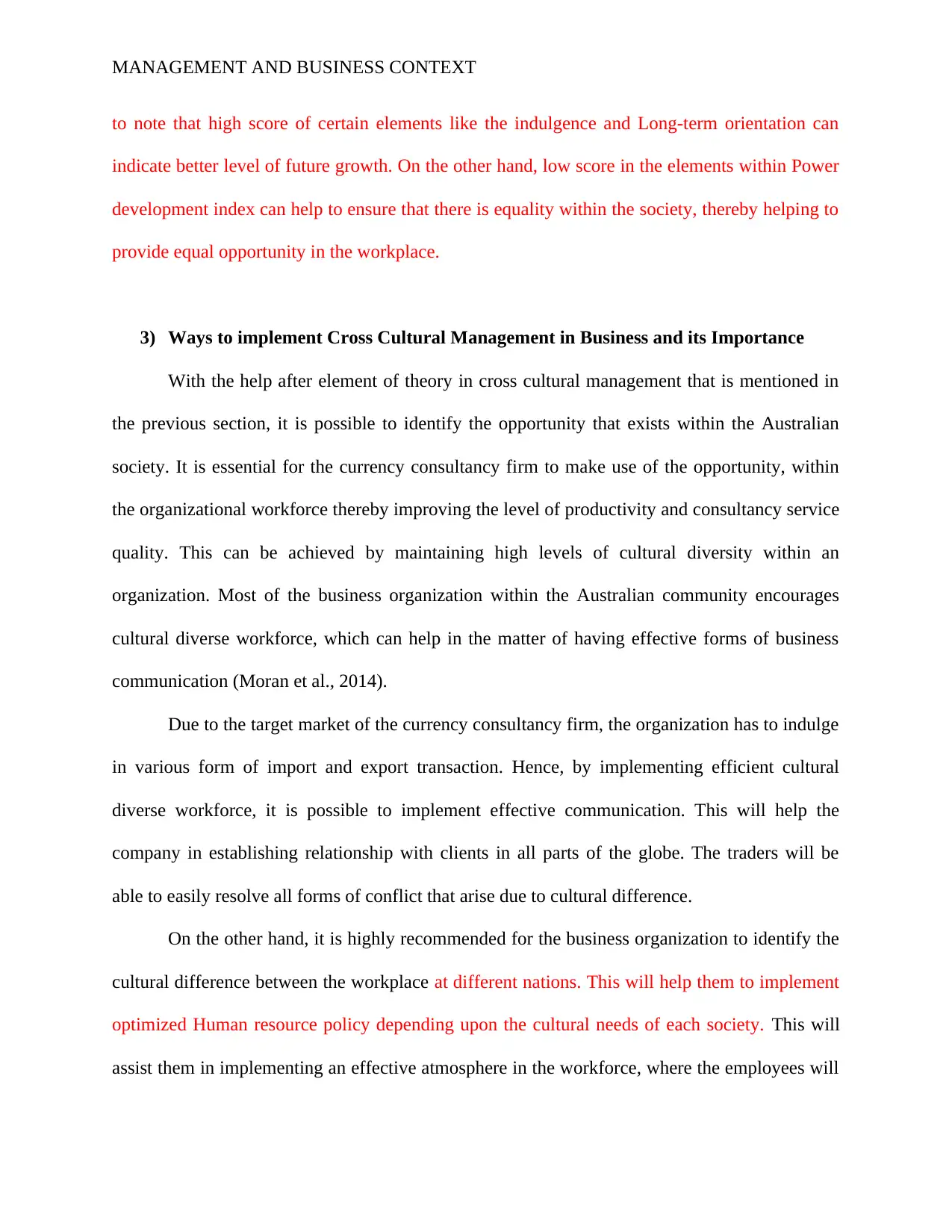
MANAGEMENT AND BUSINESS CONTEXT
to note that high score of certain elements like the indulgence and Long-term orientation can
indicate better level of future growth. On the other hand, low score in the elements within Power
development index can help to ensure that there is equality within the society, thereby helping to
provide equal opportunity in the workplace.
3) Ways to implement Cross Cultural Management in Business and its Importance
With the help after element of theory in cross cultural management that is mentioned in
the previous section, it is possible to identify the opportunity that exists within the Australian
society. It is essential for the currency consultancy firm to make use of the opportunity, within
the organizational workforce thereby improving the level of productivity and consultancy service
quality. This can be achieved by maintaining high levels of cultural diversity within an
organization. Most of the business organization within the Australian community encourages
cultural diverse workforce, which can help in the matter of having effective forms of business
communication (Moran et al., 2014).
Due to the target market of the currency consultancy firm, the organization has to indulge
in various form of import and export transaction. Hence, by implementing efficient cultural
diverse workforce, it is possible to implement effective communication. This will help the
company in establishing relationship with clients in all parts of the globe. The traders will be
able to easily resolve all forms of conflict that arise due to cultural difference.
On the other hand, it is highly recommended for the business organization to identify the
cultural difference between the workplace at different nations. This will help them to implement
optimized Human resource policy depending upon the cultural needs of each society. This will
assist them in implementing an effective atmosphere in the workforce, where the employees will
to note that high score of certain elements like the indulgence and Long-term orientation can
indicate better level of future growth. On the other hand, low score in the elements within Power
development index can help to ensure that there is equality within the society, thereby helping to
provide equal opportunity in the workplace.
3) Ways to implement Cross Cultural Management in Business and its Importance
With the help after element of theory in cross cultural management that is mentioned in
the previous section, it is possible to identify the opportunity that exists within the Australian
society. It is essential for the currency consultancy firm to make use of the opportunity, within
the organizational workforce thereby improving the level of productivity and consultancy service
quality. This can be achieved by maintaining high levels of cultural diversity within an
organization. Most of the business organization within the Australian community encourages
cultural diverse workforce, which can help in the matter of having effective forms of business
communication (Moran et al., 2014).
Due to the target market of the currency consultancy firm, the organization has to indulge
in various form of import and export transaction. Hence, by implementing efficient cultural
diverse workforce, it is possible to implement effective communication. This will help the
company in establishing relationship with clients in all parts of the globe. The traders will be
able to easily resolve all forms of conflict that arise due to cultural difference.
On the other hand, it is highly recommended for the business organization to identify the
cultural difference between the workplace at different nations. This will help them to implement
optimized Human resource policy depending upon the cultural needs of each society. This will
assist them in implementing an effective atmosphere in the workforce, where the employees will
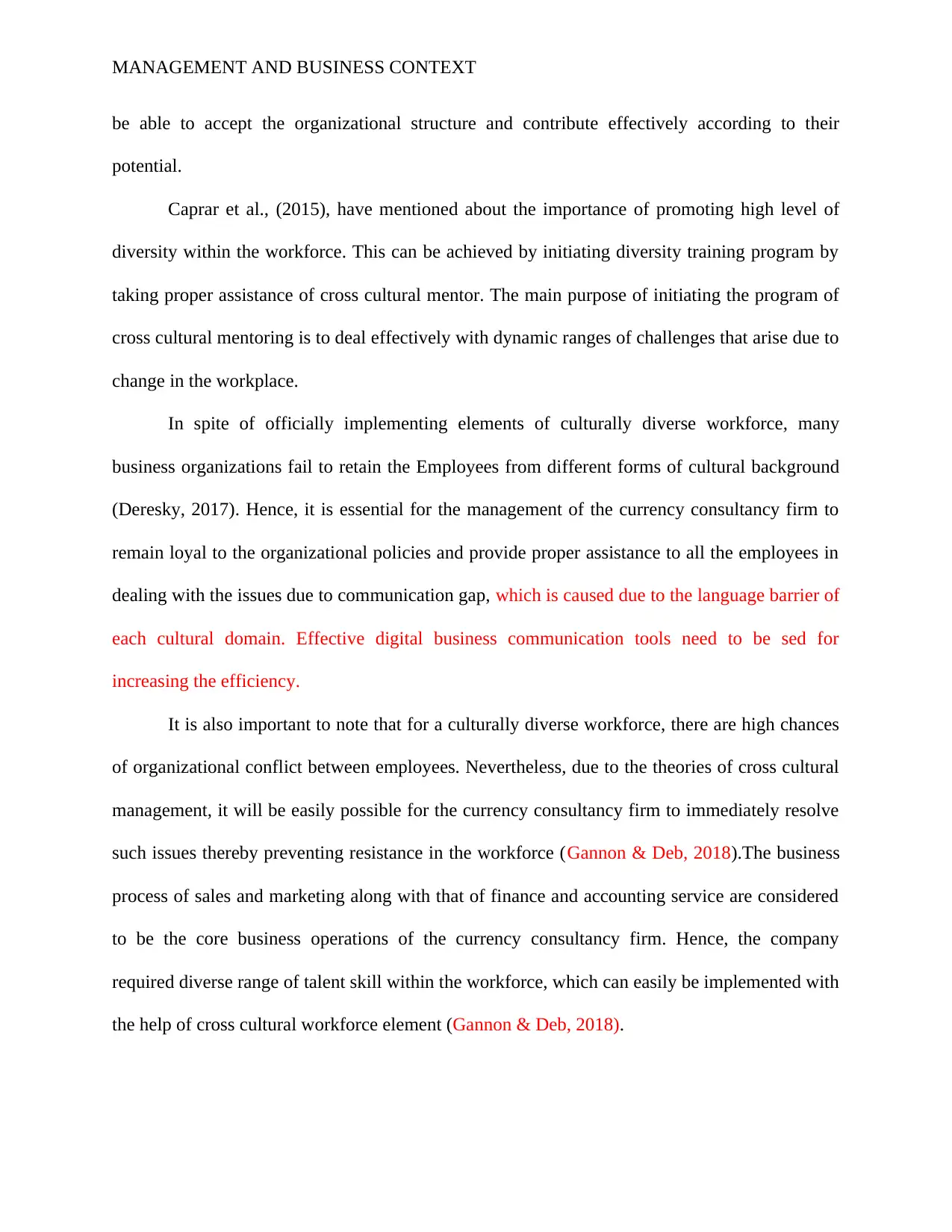
MANAGEMENT AND BUSINESS CONTEXT
be able to accept the organizational structure and contribute effectively according to their
potential.
Caprar et al., (2015), have mentioned about the importance of promoting high level of
diversity within the workforce. This can be achieved by initiating diversity training program by
taking proper assistance of cross cultural mentor. The main purpose of initiating the program of
cross cultural mentoring is to deal effectively with dynamic ranges of challenges that arise due to
change in the workplace.
In spite of officially implementing elements of culturally diverse workforce, many
business organizations fail to retain the Employees from different forms of cultural background
(Deresky, 2017). Hence, it is essential for the management of the currency consultancy firm to
remain loyal to the organizational policies and provide proper assistance to all the employees in
dealing with the issues due to communication gap, which is caused due to the language barrier of
each cultural domain. Effective digital business communication tools need to be sed for
increasing the efficiency.
It is also important to note that for a culturally diverse workforce, there are high chances
of organizational conflict between employees. Nevertheless, due to the theories of cross cultural
management, it will be easily possible for the currency consultancy firm to immediately resolve
such issues thereby preventing resistance in the workforce (Gannon & Deb, 2018).The business
process of sales and marketing along with that of finance and accounting service are considered
to be the core business operations of the currency consultancy firm. Hence, the company
required diverse range of talent skill within the workforce, which can easily be implemented with
the help of cross cultural workforce element (Gannon & Deb, 2018).
be able to accept the organizational structure and contribute effectively according to their
potential.
Caprar et al., (2015), have mentioned about the importance of promoting high level of
diversity within the workforce. This can be achieved by initiating diversity training program by
taking proper assistance of cross cultural mentor. The main purpose of initiating the program of
cross cultural mentoring is to deal effectively with dynamic ranges of challenges that arise due to
change in the workplace.
In spite of officially implementing elements of culturally diverse workforce, many
business organizations fail to retain the Employees from different forms of cultural background
(Deresky, 2017). Hence, it is essential for the management of the currency consultancy firm to
remain loyal to the organizational policies and provide proper assistance to all the employees in
dealing with the issues due to communication gap, which is caused due to the language barrier of
each cultural domain. Effective digital business communication tools need to be sed for
increasing the efficiency.
It is also important to note that for a culturally diverse workforce, there are high chances
of organizational conflict between employees. Nevertheless, due to the theories of cross cultural
management, it will be easily possible for the currency consultancy firm to immediately resolve
such issues thereby preventing resistance in the workforce (Gannon & Deb, 2018).The business
process of sales and marketing along with that of finance and accounting service are considered
to be the core business operations of the currency consultancy firm. Hence, the company
required diverse range of talent skill within the workforce, which can easily be implemented with
the help of cross cultural workforce element (Gannon & Deb, 2018).
⊘ This is a preview!⊘
Do you want full access?
Subscribe today to unlock all pages.

Trusted by 1+ million students worldwide
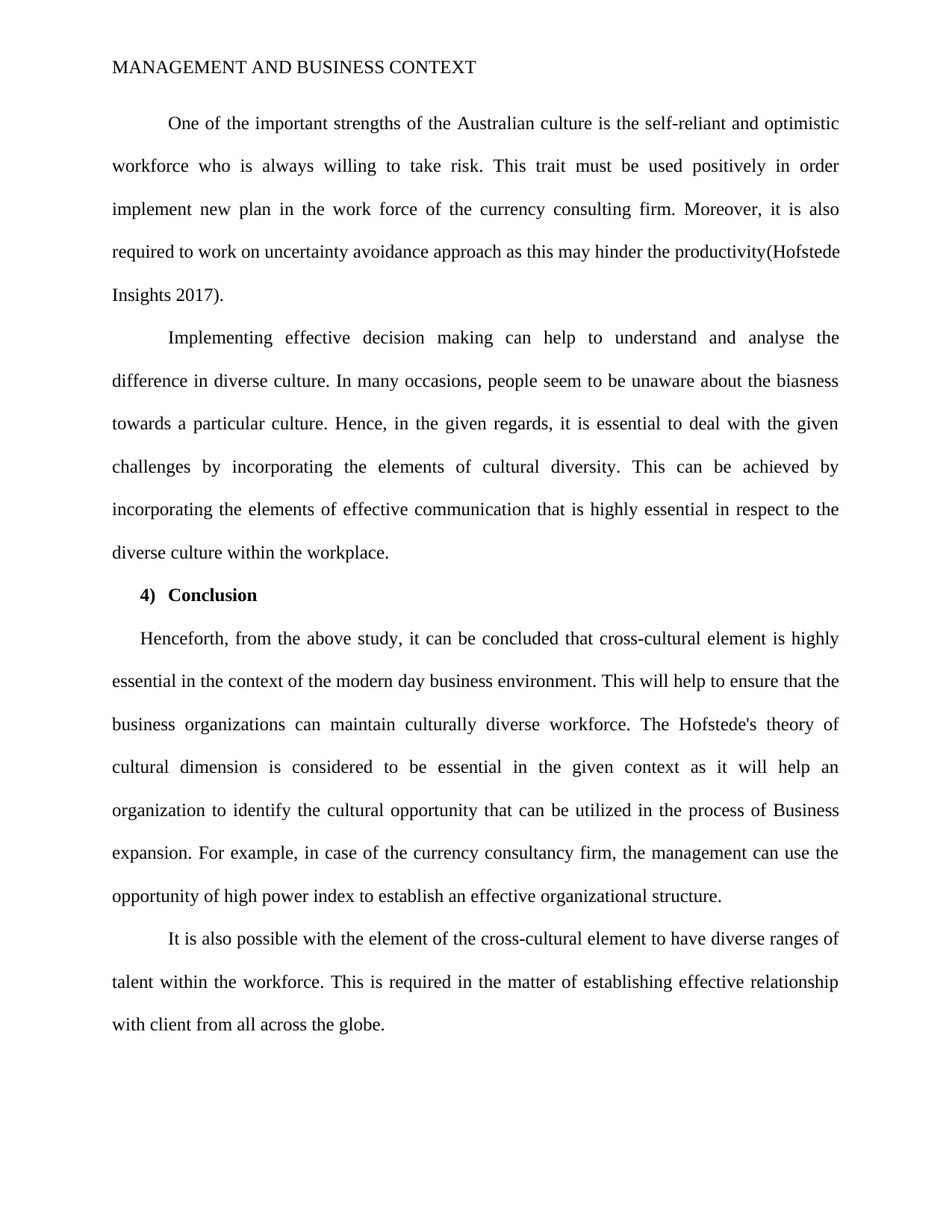
MANAGEMENT AND BUSINESS CONTEXT
One of the important strengths of the Australian culture is the self-reliant and optimistic
workforce who is always willing to take risk. This trait must be used positively in order
implement new plan in the work force of the currency consulting firm. Moreover, it is also
required to work on uncertainty avoidance approach as this may hinder the productivity(Hofstede
Insights 2017).
Implementing effective decision making can help to understand and analyse the
difference in diverse culture. In many occasions, people seem to be unaware about the biasness
towards a particular culture. Hence, in the given regards, it is essential to deal with the given
challenges by incorporating the elements of cultural diversity. This can be achieved by
incorporating the elements of effective communication that is highly essential in respect to the
diverse culture within the workplace.
4) Conclusion
Henceforth, from the above study, it can be concluded that cross-cultural element is highly
essential in the context of the modern day business environment. This will help to ensure that the
business organizations can maintain culturally diverse workforce. The Hofstede's theory of
cultural dimension is considered to be essential in the given context as it will help an
organization to identify the cultural opportunity that can be utilized in the process of Business
expansion. For example, in case of the currency consultancy firm, the management can use the
opportunity of high power index to establish an effective organizational structure.
It is also possible with the element of the cross-cultural element to have diverse ranges of
talent within the workforce. This is required in the matter of establishing effective relationship
with client from all across the globe.
One of the important strengths of the Australian culture is the self-reliant and optimistic
workforce who is always willing to take risk. This trait must be used positively in order
implement new plan in the work force of the currency consulting firm. Moreover, it is also
required to work on uncertainty avoidance approach as this may hinder the productivity(Hofstede
Insights 2017).
Implementing effective decision making can help to understand and analyse the
difference in diverse culture. In many occasions, people seem to be unaware about the biasness
towards a particular culture. Hence, in the given regards, it is essential to deal with the given
challenges by incorporating the elements of cultural diversity. This can be achieved by
incorporating the elements of effective communication that is highly essential in respect to the
diverse culture within the workplace.
4) Conclusion
Henceforth, from the above study, it can be concluded that cross-cultural element is highly
essential in the context of the modern day business environment. This will help to ensure that the
business organizations can maintain culturally diverse workforce. The Hofstede's theory of
cultural dimension is considered to be essential in the given context as it will help an
organization to identify the cultural opportunity that can be utilized in the process of Business
expansion. For example, in case of the currency consultancy firm, the management can use the
opportunity of high power index to establish an effective organizational structure.
It is also possible with the element of the cross-cultural element to have diverse ranges of
talent within the workforce. This is required in the matter of establishing effective relationship
with client from all across the globe.
Paraphrase This Document
Need a fresh take? Get an instant paraphrase of this document with our AI Paraphraser
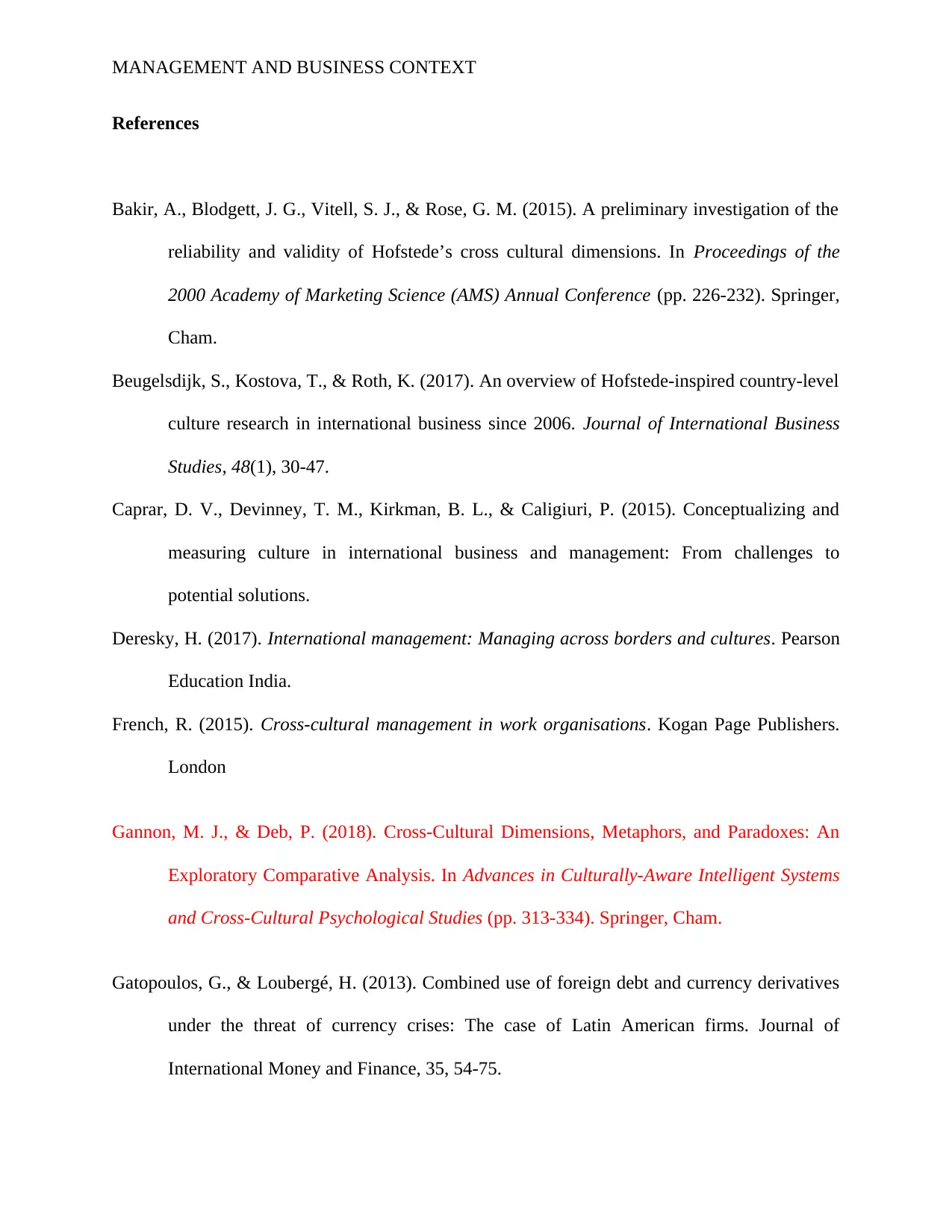
MANAGEMENT AND BUSINESS CONTEXT
References
Bakir, A., Blodgett, J. G., Vitell, S. J., & Rose, G. M. (2015). A preliminary investigation of the
reliability and validity of Hofstede’s cross cultural dimensions. In Proceedings of the
2000 Academy of Marketing Science (AMS) Annual Conference (pp. 226-232). Springer,
Cham.
Beugelsdijk, S., Kostova, T., & Roth, K. (2017). An overview of Hofstede-inspired country-level
culture research in international business since 2006. Journal of International Business
Studies, 48(1), 30-47.
Caprar, D. V., Devinney, T. M., Kirkman, B. L., & Caligiuri, P. (2015). Conceptualizing and
measuring culture in international business and management: From challenges to
potential solutions.
Deresky, H. (2017). International management: Managing across borders and cultures. Pearson
Education India.
French, R. (2015). Cross-cultural management in work organisations. Kogan Page Publishers.
London
Gannon, M. J., & Deb, P. (2018). Cross-Cultural Dimensions, Metaphors, and Paradoxes: An
Exploratory Comparative Analysis. In Advances in Culturally-Aware Intelligent Systems
and Cross-Cultural Psychological Studies (pp. 313-334). Springer, Cham.
Gatopoulos, G., & Loubergé, H. (2013). Combined use of foreign debt and currency derivatives
under the threat of currency crises: The case of Latin American firms. Journal of
International Money and Finance, 35, 54-75.
References
Bakir, A., Blodgett, J. G., Vitell, S. J., & Rose, G. M. (2015). A preliminary investigation of the
reliability and validity of Hofstede’s cross cultural dimensions. In Proceedings of the
2000 Academy of Marketing Science (AMS) Annual Conference (pp. 226-232). Springer,
Cham.
Beugelsdijk, S., Kostova, T., & Roth, K. (2017). An overview of Hofstede-inspired country-level
culture research in international business since 2006. Journal of International Business
Studies, 48(1), 30-47.
Caprar, D. V., Devinney, T. M., Kirkman, B. L., & Caligiuri, P. (2015). Conceptualizing and
measuring culture in international business and management: From challenges to
potential solutions.
Deresky, H. (2017). International management: Managing across borders and cultures. Pearson
Education India.
French, R. (2015). Cross-cultural management in work organisations. Kogan Page Publishers.
London
Gannon, M. J., & Deb, P. (2018). Cross-Cultural Dimensions, Metaphors, and Paradoxes: An
Exploratory Comparative Analysis. In Advances in Culturally-Aware Intelligent Systems
and Cross-Cultural Psychological Studies (pp. 313-334). Springer, Cham.
Gatopoulos, G., & Loubergé, H. (2013). Combined use of foreign debt and currency derivatives
under the threat of currency crises: The case of Latin American firms. Journal of
International Money and Finance, 35, 54-75.
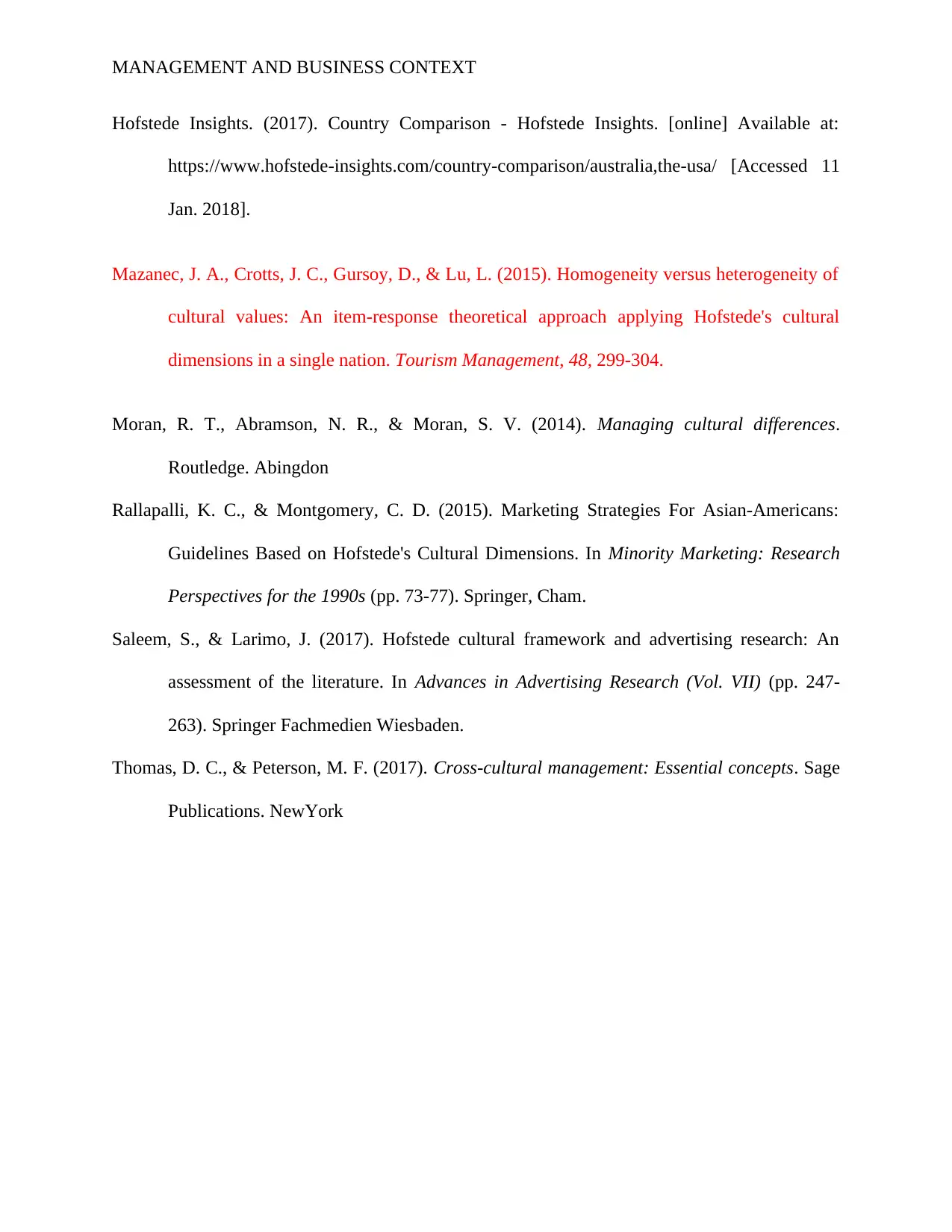
MANAGEMENT AND BUSINESS CONTEXT
Hofstede Insights. (2017). Country Comparison - Hofstede Insights. [online] Available at:
https://www.hofstede-insights.com/country-comparison/australia,the-usa/ [Accessed 11
Jan. 2018].
Mazanec, J. A., Crotts, J. C., Gursoy, D., & Lu, L. (2015). Homogeneity versus heterogeneity of
cultural values: An item-response theoretical approach applying Hofstede's cultural
dimensions in a single nation. Tourism Management, 48, 299-304.
Moran, R. T., Abramson, N. R., & Moran, S. V. (2014). Managing cultural differences.
Routledge. Abingdon
Rallapalli, K. C., & Montgomery, C. D. (2015). Marketing Strategies For Asian-Americans:
Guidelines Based on Hofstede's Cultural Dimensions. In Minority Marketing: Research
Perspectives for the 1990s (pp. 73-77). Springer, Cham.
Saleem, S., & Larimo, J. (2017). Hofstede cultural framework and advertising research: An
assessment of the literature. In Advances in Advertising Research (Vol. VII) (pp. 247-
263). Springer Fachmedien Wiesbaden.
Thomas, D. C., & Peterson, M. F. (2017). Cross-cultural management: Essential concepts. Sage
Publications. NewYork
Hofstede Insights. (2017). Country Comparison - Hofstede Insights. [online] Available at:
https://www.hofstede-insights.com/country-comparison/australia,the-usa/ [Accessed 11
Jan. 2018].
Mazanec, J. A., Crotts, J. C., Gursoy, D., & Lu, L. (2015). Homogeneity versus heterogeneity of
cultural values: An item-response theoretical approach applying Hofstede's cultural
dimensions in a single nation. Tourism Management, 48, 299-304.
Moran, R. T., Abramson, N. R., & Moran, S. V. (2014). Managing cultural differences.
Routledge. Abingdon
Rallapalli, K. C., & Montgomery, C. D. (2015). Marketing Strategies For Asian-Americans:
Guidelines Based on Hofstede's Cultural Dimensions. In Minority Marketing: Research
Perspectives for the 1990s (pp. 73-77). Springer, Cham.
Saleem, S., & Larimo, J. (2017). Hofstede cultural framework and advertising research: An
assessment of the literature. In Advances in Advertising Research (Vol. VII) (pp. 247-
263). Springer Fachmedien Wiesbaden.
Thomas, D. C., & Peterson, M. F. (2017). Cross-cultural management: Essential concepts. Sage
Publications. NewYork
⊘ This is a preview!⊘
Do you want full access?
Subscribe today to unlock all pages.

Trusted by 1+ million students worldwide
1 out of 12
Related Documents
Your All-in-One AI-Powered Toolkit for Academic Success.
+13062052269
info@desklib.com
Available 24*7 on WhatsApp / Email
![[object Object]](/_next/static/media/star-bottom.7253800d.svg)
Unlock your academic potential
Copyright © 2020–2025 A2Z Services. All Rights Reserved. Developed and managed by ZUCOL.





